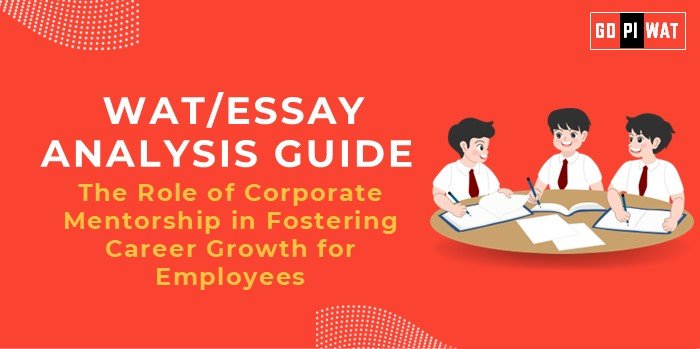📋 The Role of Corporate Mentorship in Fostering Career Growth for Employees
🌐 Understanding the Topic’s Importance
Corporate mentorship programs are essential in addressing workforce development challenges, enhancing leadership pipelines, and improving employee retention. These programs align closely with HR, leadership, and organizational development themes, making them critical in today’s competitive industries.
📝 Effective Planning and Writing
- ⏳ Time Allocation: Planning: 5 minutes | Writing: 20 minutes | Review: 5 minutes
- 📚 Preparation Tips:
- Use examples like GE’s Leadership Development Program and Microsoft’s reverse mentoring.
- Incorporate global practices and measurable outcomes to strengthen arguments.
💡 Introduction Techniques for Essays
- 🔄 Contrast Introduction: “While 70% of top global corporations invest in mentorship programs, many businesses struggle to implement scalable mentorship frameworks.”
- ✨ Solution-Based Introduction: “Corporate mentorship bridges knowledge gaps, nurtures leadership, and accelerates career growth, essential for competitive success.”
📊 Structuring the Essay Body
🏆 Achievements
- 📈 Leadership Pipelines: Strengthened through programs like GE’s Leadership Development Program.
- 🌍 Retention Impact: Companies with mentorship programs report 25% higher employee retention rates.
⚠️ Challenges
- 🔗 Mentor-Mentee Matching: Ineffective pairings reduce mentorship outcomes.
- 📉 ROI Metrics: Difficulty in tracking mentorship effectiveness hinders long-term adoption.
🔮 Future Outlook
- 🤖 AI-Driven Platforms: Enhance scalability and accuracy in mentor-mentee alignment.
- 🌟 Innovative Practices: Microsoft’s reverse mentoring highlights innovation in mentorship approaches.
📄 Concluding Effectively
- ⚖️ Balanced Conclusion: “Corporate mentorship fosters leadership, retention, and career growth, but its success lies in aligning mentorship goals with measurable outcomes.”
- 🌍 Global Comparison Conclusion: “Corporate mentorship mirrors Japan’s Senpai-Kohai model and Silicon Valley’s success, presenting a framework for sustainable growth.”
📈 Analyzing Successes and Shortcomings
- ✅ Achievements: Higher retention, leadership development, and knowledge transfer.
- ⚠️ Challenges: Time constraints, mentor fatigue, and unclear ROI metrics.
- 🌍 Global Context: Reverse mentorship in Silicon Valley; structured mentorship in Japan.
🔑 Recommendations for Sustainable Progress
- 📌 Technology Integration: Implement AI-driven platforms for mentor-mentee matching.
- 📊 Outcome Tracking: Use KPIs such as promotion rates and skill development to measure success.
📚 Sample Short Essays
⚖️ Balanced Perspective
“Mentorship programs drive employee retention and leadership development but face challenges like time constraints. Structured, data-backed mentorship ensures long-term success.”
🔍 Solution-Oriented
“AI-powered mentorship frameworks can enhance mentor-mentee alignment, ensuring mentorship fosters measurable career growth.”
🌍 Global Comparison
“Mentorship programs in Japan and Silicon Valley showcase best practices that global organizations can adopt to nurture leadership and bridge knowledge gaps.”


